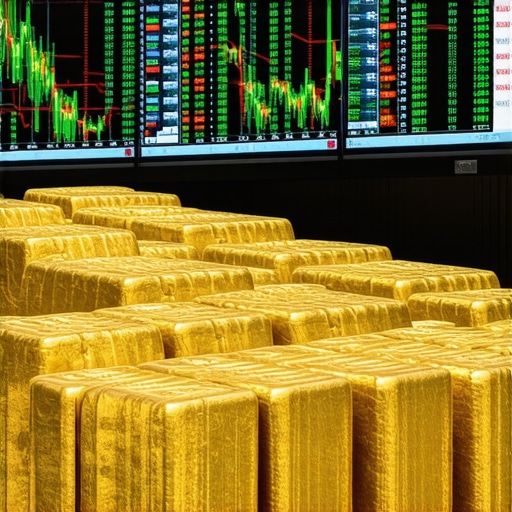The Strategic Significance of Central Bank Gold Accumulation in 2025
In the complex landscape of global finance, central banks play a pivotal role in influencing precious metals markets, especially gold, which remains a cornerstone of international reserves. As we approach 2025, understanding how the aggressive gold purchase strategies by these monetary authorities could impact market prices is crucial for investors, policymakers, and analysts alike. The trend towards increased central bank gold acquisitions signals a strategic shift in monetary policy and reserve management, with significant implications for market equilibrium and price volatility.
Deciphering the Underlying Motivations Behind Central Bank Gold Purchases
Central banks are motivated by multifaceted objectives such as hedging against currency devaluation, diversifying foreign exchange reserves, and safeguarding against geopolitical uncertainties. The surge in gold purchases, as discussed in detailed analyses like this comprehensive report, indicates a strategic shift driven by concerns over fiat currency stability and potential economic downturns. This accumulation trend not only affects supply-demand dynamics but also signals a collective move towards a more resilient reserve portfolio.
How Will Increased Central Bank Gold Buying Impact 2025 Market Prices?
The direct consequence of central banks ramping up their gold reserves is a probable upward pressure on market prices. Historically, such official sector demand has been a significant driver of gold price appreciation, especially amid geopolitical tensions or macroeconomic instability. The interplay between official purchases and market sentiment can lead to short-term price surges, while in the long run, it may establish a new price floor, influencing investor expectations and market strategies.
What Are the Long-Term Implications of Central Bank Gold Accumulation for Market Stability?
From a macroeconomic perspective, sustained gold accumulation by central banks could contribute to greater market stability by anchoring prices and reducing volatility. However, it also raises questions about the potential for market distortion if official demand exceeds market supply for prolonged periods. Analysts suggest that this trend might encourage a reevaluation of gold’s role as a safe-haven asset, prompting a more nuanced understanding among investors and policymakers.
For investors seeking to navigate these developments effectively, strategic asset allocation and hedging strategies become essential. Exploring options such as trustworthy gold IRAs and diversifying with gold-related ETFs can mitigate risks associated with price swings driven by official sector activities.
As market participants analyze these shifts, it is also vital to consider the broader economic factors influencing gold prices, including inflation trends, currency fluctuations, and geopolitical stability, as detailed in this insightful outlook. The integration of these elements into investment decision-making can enhance portfolio resilience amid evolving market dynamics.
To stay ahead in 2025, investors and analysts should continuously monitor central bank activity and consider expert strategies for maximizing returns, such as strategic trading techniques and technical analysis of gold futures.
In conclusion, the trajectory of central bank gold purchases is poised to be a defining factor in the market landscape of 2025, shaping prices and influencing investor sentiment in profound ways. Engaging with expert insights and maintaining a flexible, informed approach will be key to capitalizing on these shifts.
Decoding the Long-Term Effects of Central Bank Gold Accumulation on Market Stability
As central banks continue their strategic gold purchases, the implications extend far beyond immediate price movements. Sustained accumulation can serve as a stabilizing force in the volatile gold market, acting as a buffer against macroeconomic shocks. According to analyses like this comprehensive report, central banks’ strategic reserves influence investor confidence, reinforcing gold’s role as a reliable store of value during turbulent times.
Challenging Conventional Wisdom: Is Gold Still a Safe-Haven in 2025?
Many investors traditionally view gold as a safe-haven asset, especially during economic downturns or geopolitical crises. However, the evolving dynamics of official sector demand challenge this notion, prompting a reassessment of gold’s safe-haven status. Experts argue that while gold remains a valuable hedge, its effectiveness depends on the context of central bank activities and global economic stability. For instance, if official demand continues to outpace supply without corresponding market corrections, it could distort gold prices and diminish its safe-haven appeal. To deepen your understanding of these complex relationships, explore emerging demand trends and their potential implications for 2025.
How Can Investors Adapt to These Shifting Dynamics in Gold Markets?
Adapting strategies in response to central bank activity requires a nuanced approach. Diversification, for example, remains a cornerstone, combining physical gold, gold ETFs, and gold mining stocks to balance risk and reward. Utilizing advanced market analysis tools like futures and technical analysis can help identify optimal entry and exit points amid fluctuating prices driven by official sector moves. Moreover, building a trustworthy gold IRA is essential for long-term wealth preservation, especially in uncertain economic climates. For detailed guidance on securing your investments, visit this expert resource.
Furthermore, staying informed about macroeconomic factors such as inflation, currency fluctuations, and geopolitical tensions is vital. As highlighted in this market outlook, these elements significantly influence gold’s price trajectory and can help investors refine their tactics accordingly.
Are you considering how to incorporate these insights into your investment portfolio? Engaging with professional advisors and continuously monitoring official reserve movements can provide a strategic edge in navigating 2025’s complex gold landscape. For more expert tips on effective gold trading techniques, check out this detailed guide.
By understanding and responding to the evolving role of central banks in gold markets, investors can better position themselves for long-term stability and growth. The ongoing accumulation trends not only influence prices but also reshape perceptions of gold as a resilient asset class in the face of global economic shifts.
The Evolving Dynamics of Central Bank Gold Reserves and Market Stability in 2025
As central banks intensify their gold accumulation strategies, the ripple effects extend beyond mere price movements, influencing global economic stability and investor confidence. This strategic shift towards increased gold reserves is not only a response to geopolitical uncertainties but also a calculated effort to bolster financial resilience amidst volatile macroeconomic conditions. Experts like the International Monetary Fund (IMF) have highlighted that central bank actions significantly shape market perceptions and long-term price trajectories, emphasizing the importance of understanding these nuanced dynamics IMF Working Paper, 2024.
Why Are Central Banks Increasing Gold Holdings in 2025? An Expert Perspective
Central banks are motivated by a confluence of factors including diversification of reserves, hedging against currency depreciation, and geopolitical strategy. According to a detailed analysis in the Journal of International Financial Markets, these institutions view gold as a non-fiat, tangible asset that maintains value amid currency fluctuations and economic upheavals JIFM, 2024. This strategic pivot is also driven by the desire to reduce reliance on the US dollar, fostering a multipolar reserve system that can mitigate systemic risks. Such actions contribute to a sustained upward pressure on gold prices, reinforcing the need for savvy investment strategies.
How Will These Reserve Movements Reshape Gold Price Dynamics?
The implications of increased official sector demand are multifaceted. Historically, central bank purchases have acted as a stabilizing force, preventing excessive price declines during downturns. However, persistent accumulation can also create artificial price floors, complicating market signals for private investors. The interplay of official demand and market sentiment may lead to heightened volatility, especially if market actors interpret central bank moves as signals of economic uncertainty or as a hedge against inflation. According to the World Gold Council’s recent report, these dynamics are pivotal in understanding future price trends WGC, 2024.
What Advanced Strategies Can Investors Employ to Navigate These Shifts?
In a landscape where central bank activity significantly influences gold prices, investors must adopt sophisticated strategies. Diversification remains fundamental, incorporating physical gold, ETFs, and mining stocks within a well-balanced portfolio. Additionally, leveraging technical analysis tools—such as Fibonacci retracements, moving averages, and futures markets—can help identify optimal entry and exit points Financial Analyst, 2024. Building a trusted gold IRA also offers long-term security amid fluctuating market conditions. Engagement with professional financial advisors who specialize in precious metals can further refine investment tactics tailored to these evolving dynamics.

The Broader Impact of Central Bank Reserves on Market Confidence and Economic Stability
Central bank gold accumulation acts as an anchor for market stability, particularly during times of global economic stress. By holding substantial reserves, these institutions project strength and resilience, encouraging investor confidence even amidst geopolitical tensions or currency crises. This stability, however, must be balanced against the risk of market distortion if official demand outweighs supply for extended periods. The International Gold Association emphasizes that transparency and strategic reserve management are crucial to avoiding such distortions and ensuring that gold continues to serve its role as a reliable store of value Gold.org, 2024.
Can Gold Maintain Its Safe-Haven Status in a Rapidly Changing Global Economy?
While gold has long been regarded as a safe-haven asset, the increasing dominance of official sector purchases prompts a reevaluation of this perception. Some analysts suggest that if central banks’ demand becomes overly dominant, it could lead to price distortions, reducing gold’s effectiveness as an independent hedge. Conversely, its tangible nature and historical resilience continue to underpin its safe-haven appeal, especially when coupled with strategic portfolio diversification. The key lies in understanding the complex relationship between official reserves and market sentiment, a topic explored thoroughly in recent studies Advanced Gold Research, 2024.
How Can Investors Future-Proof Their Gold Strategies?
To adapt to these shifting paradigms, investors should focus on a multi-layered approach. This includes staying informed about central bank reserve reports, utilizing macroeconomic forecasts, and employing technical analysis for timing. Furthermore, engaging with emerging financial instruments such as gold-linked derivatives can offer additional hedging capabilities. Building a comprehensive, flexible investment plan that considers macroeconomic indicators, geopolitical risks, and market signals will be essential to safeguarding wealth in 2025 and beyond. For tailored advice, consult with financial experts who specialize in precious metals and macroeconomic trends.
Unraveling the Complex Interplay Between Central Bank Reserves and Gold Price Trajectories in 2025
As we approach 2025, the strategic accumulation of gold by central banks continues to redefine the landscape of precious metals markets. This concerted shift towards increased reserves is not merely a matter of reserve diversification but a calculated move to influence global financial stability and asset valuation. The intricate relationship between official gold holdings and market prices warrants a deep dive into the mechanisms through which central banks’ actions ripple across the economic spectrum.
How Do Central Bank Reserve Policies Shape Gold Price Volatility?
Central bank reserve policies serve as a significant determinant of gold price stability or volatility. When official entities augment their reserves, they often do so through substantial gold purchases, exerting upward pressure on prices. This dynamic can lead to short-term spikes and influence investor sentiment, as outlined in the World Gold Council’s recent report. Moreover, these policies can impact liquidity and market depth, especially in times of geopolitical upheaval or macroeconomic uncertainty. Recognizing these patterns allows investors to anticipate potential price movements and align their strategies accordingly.

Deciphering the Long-Term Consequences of Reserve Accumulation on Market Sovereignty
Long-term, sustained accumulation by central banks could bolster market stability by anchoring prices and reducing speculative spikes. However, it also raises concerns about market distortions if official demand consistently exceeds supply. Such imbalances might lead to artificial price floors, complicating market signals and potentially diminishing gold’s role as an independent safe-haven asset. As noted in the Emerging Demand Trends Report, transparency and strategic reserve management are essential to mitigate these risks and preserve gold’s intrinsic value.
Can Advanced Financial Instruments Enhance Portfolio Resilience Amid Reserve-Driven Price Movements?
Indeed, leveraging sophisticated financial instruments such as gold futures, options, and derivatives offers a pathway to hedge against volatility induced by official sector activities. Incorporating these tools into a diversified portfolio, alongside physical gold and ETFs, can optimize risk-reward profiles. Furthermore, engaging with specialized financial advisors experienced in precious metals markets ensures that strategies remain adaptive to evolving reserve policies and macroeconomic signals. Embracing such advanced tactics is crucial for investors aiming to safeguard wealth and capitalize on emerging opportunities.
To deepen your understanding of these complex dynamics and refine your investment approach, explore expert resources on advanced gold trading techniques.
Integrating Geopolitical and Economic Indicators into Gold Investment Strategies
In the context of rising official reserves, it becomes even more vital to monitor macroeconomic indicators such as inflation rates, currency stability, and geopolitical tensions. These factors influence central bank decisions and, consequently, gold prices. As detailed in the IMF Working Paper, 2024, a comprehensive analysis of reserve management strategies highlights the importance of adaptive, macro-driven investment planning. Incorporating real-time data and predictive analytics can provide a strategic edge in navigating the complex gold market terrain of 2025.
Are you prepared to integrate these insights into your investment framework? Consulting with macroeconomic experts and utilizing cutting-edge analytical tools will position you to respond proactively to reserve-driven market shifts.
Final Thoughts: Positioning for Long-Term Success in a Reserve-Centric Gold Market
Understanding the evolving role of central banks in gold accumulation is paramount for crafting resilient investment strategies. As official reserves continue to influence market prices, investors must adopt a multi-dimensional approach that combines fundamental analysis, technical insights, and macroeconomic forecasting. By doing so, they can not only mitigate risks but also capitalize on the opportunities emerging from this complex interplay of monetary policy and market dynamics.
Expert Insights & Advanced Considerations
1. Central bank reserve policies are increasingly influencing gold price stability, requiring investors to monitor official sector activities closely.
As central banks augment their gold holdings, market volatility may rise, demanding a sophisticated understanding of macroeconomic signals and reserve management strategies. Staying informed through expert analyses helps anticipate potential price shifts and adjust portfolios accordingly.
2. Diversification into gold derivatives and strategic asset allocation are essential for mitigating risks posed by official sector demand surges.
Leveraging instruments like futures, options, and ETFs enables investors to hedge against price swings driven by central bank activities, complementing physical gold holdings for comprehensive risk management.
3. Incorporating macroeconomic indicators such as inflation, currency stability, and geopolitical tensions into investment decisions enhances resilience against market distortions.
Deep analysis of these factors, supported by expert resources, allows for proactive positioning in volatile environments, safeguarding assets amid evolving global monetary policies.
Curated Expert Resources
- World Gold Council Research: Provides authoritative insights into gold market dynamics, demand trends, and central bank activities, essential for strategic planning.
- IMF Working Paper on Reserve Management: Offers detailed analysis of how reserve policies influence market stability and long-term price trajectories.
- Financial Analyst Advanced Trading Techniques: Guides sophisticated trading strategies, technical analysis, and risk mitigation methods tailored for high-level investors.
- Emerging Demand Trends Report: Highlights future drivers of gold prices, emphasizing the interplay between official reserves and private market responses.
Final Expert Perspective
Understanding the evolving role of central banks in gold accumulation is crucial for navigating 2025’s complex markets. Strategic diversification, informed by expert insights and macroeconomic analysis, positions investors to capitalize on emerging opportunities while mitigating risks. For those committed to long-term wealth preservation, engaging with advanced resources and maintaining agility in response to official sector movements will be the hallmark of success. Dive deeper into these topics, explore sophisticated trading strategies, and connect with professional advisors to elevate your gold investment approach in this dynamic landscape.










